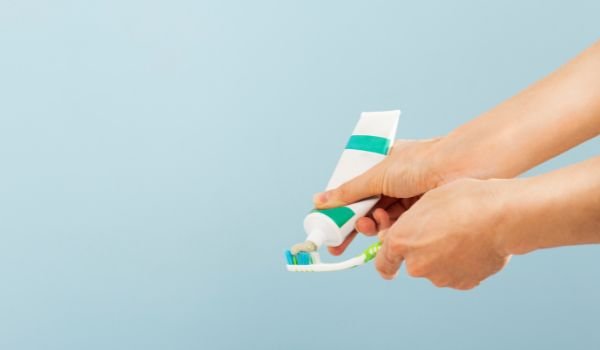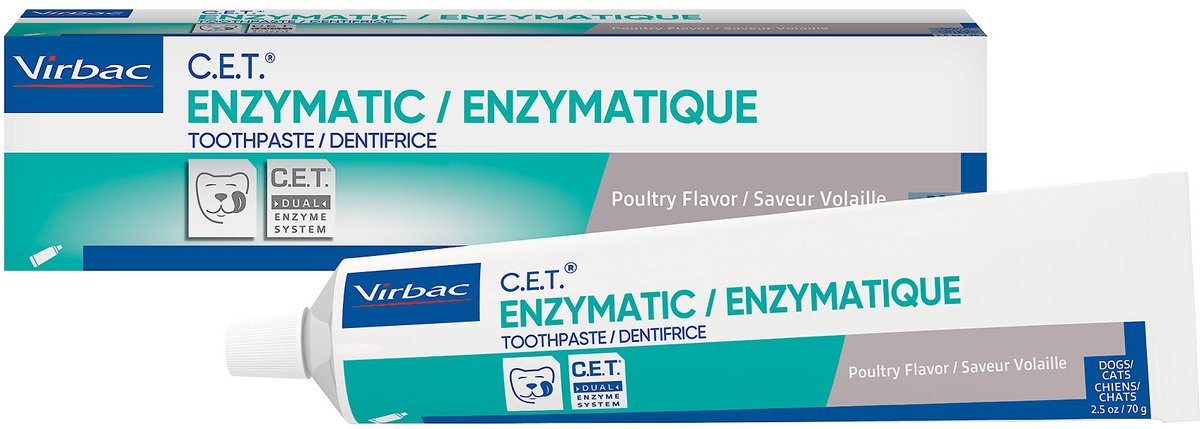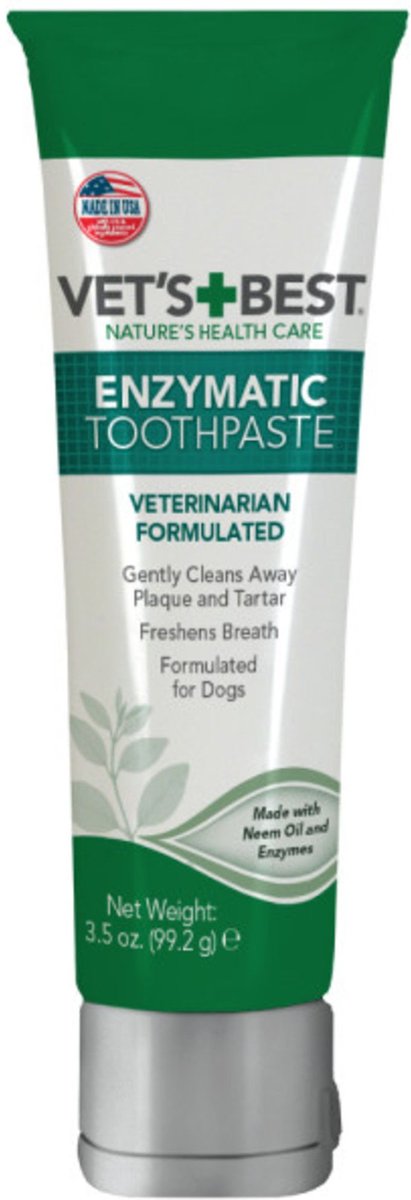Dogs! You cannot do much about their habit of sniffing and eating whatever comes their way! At best, you can only avoid letting them eat certain items; if you fail to do so, you are left with no option other than to manage the emergency.
That is why queries like “can dogs eat toothpaste” often pop up because you can – literally – expect fidos to consume items that are not treats but only cleaners.
Let us dig deeper to know more, but a short answer is: No. Dogs eating toothpaste is no less than a disaster.
Can Dogs Eat Toothpaste?
No, dogs cannot eat toothpaste, human or otherwise.
If your dog has consumed dog toothpaste, there would not be much to worry about – especially if he has spared the plastic and focused only on the paste. However, if he has eaten human toothpaste, it could be no less than a disaster: the ingredients contained in it, particularly xylitol, can have detrimental effects on canine health.
In severe cases, it may be fatal.
Ingredients in Toothpaste Harmful to Dogs
Sweeteners
Human toothpaste contains artificial sweeteners to taste pleasant and is fine for us, but it hurts dogs. There are different kinds of sweeteners, such as sorbitol but the most important one to look out for is xylitol because it can lead to hypoglycemia – a dangerously low level of blood sugar – within as low as 10 to 15 minutes of consumption.
It becomes especially toxic if eaten at 50 mg per kilogram body weight—ingesting 50g/kg could lead to acute liver failure. That said, teacup dog breeds may be at far greater risk by ingesting even a small amount of human toothpaste.
If xylitol succeeds in producing a massive amount of insulin in the canine body, excessive vomiting, lethargy, and in the worst-case scenario, seizures cause death.
Fluoride
Fluoride is commonly found in human toothpaste due to its dental benefits. Though its higher amount can cause health issues in human beings too, any quantity of more than five mg per kilogram body weight can be harmful to canines.
If eaten in substantial amounts, fluoride can be highly toxic. At worst, it may cause death within 90 minutes of consumption. Other issues include excessive sweating, weakness, rapid breathing, and a fast heartbeat.
Baking Soda
Baking soda is an acidic substance present in human toothpaste, and if ingested in large quantities (more than 20 mg per kilogram of body weight), it can cause various problems. For instance, it can expand in the stomach, causing serious irritation and bloating.
The initial signs of baking soda toxicity include diarrhea, vomiting, and breathing difficulties. If baking soda manages to create a massive electrolyte imbalance in a dog’s body, it can lead to death.
Sodium Lauryl Sulfate (SLS)
Have you ever wondered why dog toothpaste does not foam? It is because it is void of SLS, while human toothpaste is not. Other than that, this particular chemical has no real purpose. If ingested, it can cause severe gastrointestinal issues in dogs.
Besides, SLS can stay in the system for long and causes damage to other vital organs such as the heart, brain, and liver.
Plastic
Plastic is common in both human and dog toothpaste. So, even the toothpaste specifically designed for our furry friends is sure to cause issues if they eat its casing. But unlike the ingredients discussed above, it is not toxic and can only be fatal if it causes any obstruction.
Usually, it causes gut irritation, vomiting, and severe pain and comes out with feces.
What to Do If Your Dog Has Eaten Toothpaste?
Crisis! If your dog has eaten toothpaste or its casing, you should contact your vet immediately.
But until you reach help, consider doing the followings:
- Prevent further consumption of toothpaste.
- Do not let your dog eat or drink afterward. It can obstruct plastic sever.
- Do not panic if your dog shows any severe symptoms.
- Try calling the American Society for the Prevention of Cruelty to Animals (ASPCA) Poison Control Centre or the Pet Poison Helpline to seek guidance at home.
- Try to induce vomiting in your dog.
How Do Vets Treat Dogs Who Have Eaten Toothpaste?
Vets find out what exactly your dog has eaten and treat him correspondingly. You can ease it up for your vet by noting whether your dog has eaten the toothpaste or its plastic, the quantity of the toothpaste or plastic, the time the incident occurred, and the product’s main ingredients.
If Your Dog Has Eaten Toothpaste
The vet will first determine which toothpaste ingredient has caused toxicity in your pooch by looking at the symptoms and will treat him accordingly. For instance, if xylitol – the most threatening ingredient – is the culprit, the vet will go for intravenous fluids therapy to maintain healthy blood sugar and hydration levels. The same goes for fluoride toxicity, but the vet may also try to induce vomiting in your pet if not much time has elapsed.
Finally, in the case of baking soda toxicity, the vet will not go for inducing vomiting and will treat the dog using different methods.
If Your Dog Has Eaten Plastic
Treating dogs who consume plastic depends on how much time has passed since ingestion. If it is below four hours, inducing vomiting will work fine, but if it is above that, vets prefer to let it pass through the rear end. However, if the plastic is too big for your dog, fearing obstruction, the vet might recommend x-ray scans and surgery.
How Much Time Does Recovery Take?
At a minimum, the vet may get your furry pal admitted to the hospital for 24 hours. This is the time required for administering the treatment only. Besides, the vet may also keep him admitted for another day to monitor his health conditions.
Once released, the vet will recommend regular blood profile tests for three to four days, especially in the case of xylitol toxicity, to ensure that it is suppressed and there is no impact on the liver. Combining all, on average, you can expect your canine buddy to recover within a week after consuming toothpaste.
Can Human Toothpaste Be Used for Dogs if Not Ingested?
A strict no – never be tempted to use human toothpaste to clean your dog’s teeth. Even if no xylitol, fluoride, or baking soda is mentioned on the toothpaste label, keeping your dog away from human toothpaste is still recommended.
Only use toothpaste specially designed for dogs. Fortunately, plenty of brands manufacture them, and they are also easily available.
How to Avoid Your Dog Eating Toothpaste?
Prevention is better than cure. Never let your dog consume toothpaste in the first place to ensure he always stays fit and healthy.
Training
You can raise a well-behaved dog through effective training, but you should not ignore the dimension of simple commands to immediately abort any of his deeds when doing so. If you catch your pooch red-handed with a tube of toothpaste in his mouth, you should say ‘drop!’ emphatically, and he should leave it immediately.
Concealing Toothpaste
Never leave your toothpaste, mouthwash, or any other product containing the ingredients discussed above in the open to where your dog has access. Dogs are innately curious, and sooner or later, they will end up eating such products in access. Keep them in closed cupboards above the ground.
Supervision
Never leave your dog unsupervised. You might increase the risk of your dog eating toothpaste or even any other food, such as chocolate, toxic to his health if you do so.
Conclusion: Can Dogs Eat Toothpaste?
No, dogs cannot eat toothpaste, especially those for the use of human beings. They contain xylitol, fluoride, baking soda, and SLS, all highly detrimental to canine health. If your pooch consumes the plastic casing and cap as well, it can further complicate his well-being. Though timely actions may lead to complete recovery within a week, it is recommended not to let your dog have any toothpaste in the first place.



